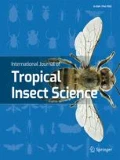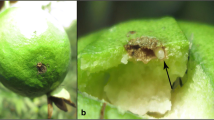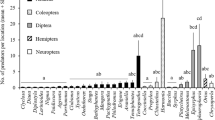Abstract
In West and Central Africa, panicle-feeding mirid bugs, particularly Eurystylus oldi Poppius (Hemiptera: Miridae), are major pests of improved sorghum cultivars. Population dynamics of panicle-feeding bugs were studied on the sorghum cultivar ICSV 197, sown on eight dates each year from 1992 to 1994 at Samanko, Mali. Relationships between weather factors and abundance of panicle-feeding bugs were examined for the three most commonly found mirids, E. oldi, Campylomma spp. and Creontiades pallidus Rambur (representing on average respectively 58, 39 and 2% of all mirid species). Although only one generation of E. oldi could develop between flowering and grain maturity on a particular panicle, there were three successive generations each year during the extended grain-maturing period in the experiment with eight sowing dates, with a major peak in abundance in early October, followed by a gradual decrease until late November. Abundance of Cr. pallidus peaked in late October, while that of Campylomma spp. showed no relationship with date of sowing.
An increase in abundance of E. oldi nymphs (y1) was favoured by high precipitation, reduced maximum temperature and high minimum relative humidity during and 2–3 weeks before the grain-filling period [a strong negative relationship was found with the number consecutive days without precipitation from 78–88 days after sowing (das) (x1): y1 = -11.7x1 + 149.3 (r2 = 0.67)]. The abundance of Cr. pallidus (y2) was correlated with wide temperature ranges and low precipitation during the same periods (notably precipitation frequency from 75–91 das: x2): y2 = -2.28x2 + 24.6 (r2 = 0.65). The abundance of Campylomma spp. (y3) was negatively correlated with amount of rainfall between 19–32 das (x3): y3 = -3.82x3 + 705.9 (r2 = 0.49). Reasons for these trends are suggested and their possible application for management of panicle-feeding bugs discussed.
Résumé
En Afrique Centrale et de l’Ouest, les punaises mirides des panicules, particulièrement Eurystylus oldi Poppius, sont des ravageurs-clés des variétés améliorées de sorgho. Les populations de punaises ont été suivies sur la variété de sorgho ICSV 197, semée à huit dates différentes chaque année de 1992 à 1994 à Samanko au Mali. Les relations entre facteurs climatiques et populations ont été examinées pour les trois principaux mirides, £. oldi, Campylomma spp. et Creontiades pallidus Rambur (représentant en moyenne respectivement 58, 39 et 2% des espèces de mirides). Bien qu’une seule génération d’E. oldi puisse se développer entre la floraison et la maturité du grain sur une panicule, trois générations se sont succédées chaque année pendant la longue période de maturation du grain sur l’essai avec huit dates de semis, avec un pic principal de pullulation début octobre, suivi d’une baisse régulière jusqu’à fin novembre. Les populations de Cr. pallidus ont culminé fin octobre; celles de Campylomma spp. n’ont présenté aucune relation avec la date de semis. Une faible température maximum, une forte humidité relative minimum et de fortes précipitations pendant les 2–3 semaines précédents le remplissage du grain ont favorisé l’augmentation des populations larvaires d’E. oldi (yl)[forte corrélation négative notamment avec le nombre de jours sans pluies de 78 à 88 jours après semis (JAS) (x1): y1= 11.7x1+ 149.3 (r2 = 0.67)]. De fortes populations de Cr. pallidus (y2) sont associées à de grandes amplitudes thermiques et à de faibles précipitations simultanées (notamment la fréquence des précipitations de 75 à 91 JAS: x2): y2 = 2.28x2 + 24.6 (r2 = 0.65). Les nombres de Campylomma spp. (y3) sont corrélés négativement avec la pluviométrie 19–32 JAS (x3): y3 = -3.82x3 + 705.9 (r2 = 0.49). Des explications permettant d’interpréter ces tendances sont avancées, et on discute de leur application possible pour la lutte contre les punaises.
Similar content being viewed by others
References
Agrawal B. L., Sharma H. C. and Leuschner K. (1987) Registration of ‘ICSV 197’ midge resistant sorghum cultivar. Crop Sci. 27, 1312–1313.
Bal A. B. and Anadif Issa T. (1998) Effet de la date de semis du sorgho (Sorghum bicolor) sur Eurystylus oldi (Hemiptera, Miridae) et Contarinia sorghicola (Diptera, Cecidomyidae). J. Afr. Zool. 112, 241–248.
Coakley S. M., McDaniel L. R. and Line R. F. (1988) Quantifying how climatic factors affect variation in plant disease severity: A general method using a new way to analyze meteorological data. Climate Change 12, 157–175.
Doumbia Y. O. and Bonzi S. M. (1985) Note sur les problèmes des insectes des panicules du sorgho au Mali, pp. 173–182. In Proceedings of the West African Regional Sorghum Network Workshop, 21–24 October 1985, Bamako, Mali. SAFGRAD/ICRISAT, Ouagadougou, Burkina Faso.
Doumbia Y. O. and Teetes G. L. (1994) Distribution, dégâts et dynamique des populations d’Eurystylus marginatus (Heteroptera, Miridae) ravageurs du sorgho au Mali, pp. 321–331. In Progress in Food Grain Research and Production in Semi-Arid Africa: Proceedings of the SAFGRAD Inter-Network Conference, 7–14 March 1991, Palais des Congrès, Niamey, Niger (Edited by J. M. Menyonga, T. Bezuneh, J. Y Yayock and I. Soumana). SAFGRAD, Ouagadougou, Burkina Faso.
MacFarlane J. (1989) The hemipterous insects and spiders of sorghum in Northern Nigeria. Insect Sci. Applic. 10, 277–284.
Ratnadass A. and Ajayi O. (1995) Panicle insect pests of sorghum in West Africa, pp. 29–38. In Panicle Insect Pests of Sorghum and Pearl Millet: Proceedings of an International Consultative Workshop, 4–7 October 1993, ICRISAT Sahelian Centre, Niamey, Niger (Edited by K. F. Nwanze and O. Youm). ICRISAT, Patancheru, Andhra Pradesh, India.
Ratnadass A., Chantereau J., Coulibaly M. F. and Cilas C. (2002) Inheritance of resistance to the panicle-feeding bug Eurystylus oldi and the sorghum midge Stenodiplosis sorghicola in sorghum. Euphytica 123, 131–138.
Ratnadass A., Cissé B., Diarra D. and Sangaré M. L. (1997) Indigenous host plants of sorghum head-bugs (Heteroptera: Miridae) in Mali. African Entomology 5, 158–160.
Ratnadass A., Cissé B. and Mallé K. (1994a) Notes on the biology and immature stages of West African sorghum head-bugs Eurystylus immaculatus and Creontiades pallidus (Heteroptera: Miridae). Bull. Entomol. Res. 84, 383–388.
Ratnadass A., Ramaiah K. V., Sharma H. C. and Cissé B. (1994b) Réaction de variétés de sorgho aux attaques de la punaise des panicules Eurystylus immaculatus Odhiambo (Heteroptera, Miridae) en Afrique de l’Ouest, pp. 333–343. In Progress in Food Grain Research and Production in Semi-Arid Africa: Proceedings of the SAFGRAD Inter-Network Conference, 7–14 March 1991, Palais des Congrès, Niamey, Niger (Edited by J. M. Menyonga, T. Bezuneh, J. Y Yayock and I. Soumana). SAFGRAD, Ouagadougou, Burkina Faso.
Sharma H. C. and Lopez V. F. (1990) Biology and population dynamics of sorghum head-bugs (Hemiptera: Miridae). Crop Prot. 9, 163–173.
Steck G. J., Teetes G. L. and Maïga S. D. (1989) Species composition and injury to sorghum by panicle feeding bugs in Niger. Insect Sci. Applic. 10, 199–217.
Stonedahl G. M. (1995) Taxonomy of African Eurystylus (Heteroptera: Miridae), with a review of their status as pests of sorghum. Bull. Entomol. Res. 85, 135–156.
Author information
Authors and Affiliations
Corresponding author
Rights and permissions
About this article
Cite this article
Ratnadass, A., Butler, D.R. Abundance of Sorghum Panicle-Feeding Bugs (Hemiptera: Miridae) in Mali and Empirical Relationships with Weather. Int J Trop Insect Sci 23, 239–250 (2003). https://doi.org/10.1017/S1742758400023638
Accepted:
Published:
Issue Date:
DOI: https://doi.org/10.1017/S1742758400023638




